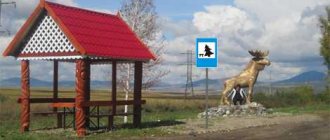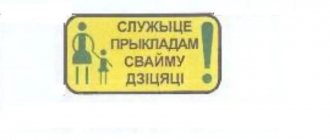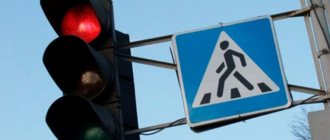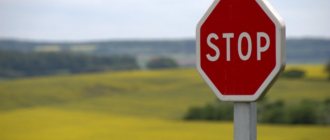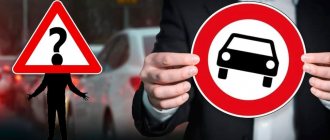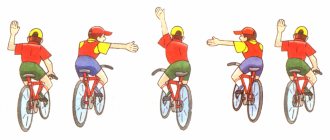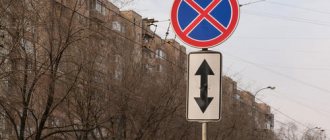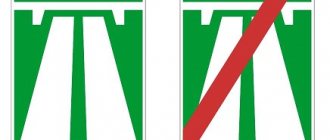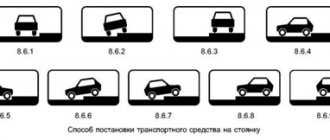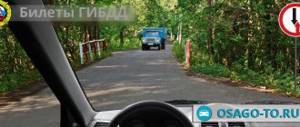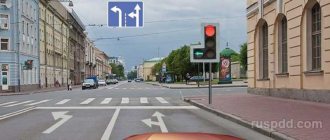Sign 6.5 “Emergency stop lane”
Sign 6.5 “Emergency stop lane” is used to inform vehicle drivers about the location of the emergency stop lane on a steep descent.
On long descents (often in mountainous areas), brake failure may occur. Any reason for this failure is possible. For such cases, on steep slopes, special places are organized in which the profile of the road is artificially changed from downhill to uphill (they make a long embankment leading uphill).
The car, unable to brake, slides down this embankment and, having lost speed, stops.
The sign is installed before entering the emergency stop lane.
At the top of the descent, together with sign 1.13 “Steep descent”, a preliminary sign 6.5 “Emergency stop lane” is installed with sign 8.1.1 “Distance to object”. Another preliminary sign 6.5 may be installed along the descent with another sign 8.1.1 “Distance to object”.
Rules for installing a sign
The beginning of the sign.
The sign is installed directly in front of the section of the road on which the restriction is imposed.
Begins to operate from the place where the sign is installed.
The effect of the sign extends only to the side of the road on which they are installed.
End of the sign.
The coverage area extends to:
- sign
- the nearest intersection behind it,
- in populated areas in the absence of an intersection - to the end of the populated area.
- the effect of the signs is not interrupted at exit points from areas adjacent to the road and at intersections (junctions) with field, forest and other secondary roads in front of which the corresponding signs are not installed.
- by installing repeated ones with a sign at the end of their coverage area
- by installing repeated ones with a sign at the end of their coverage area
The coverage area of signs may be reduced:
- installation together with the sign plate
- can be used in conjunction with markings, and the coverage area of the signs is determined by the length of the marking line.
Who does the sign not apply to?
The signs do not apply to:
- route vehicles;
Signs 6.6, 6.7 “Underground and overground pedestrian crossing”
Sign 6.6 “Underground pedestrian crossing” is used to indicate the place of crossing the roadway underground.
The entrance to the underground passage is a descent organized by steps into a pedestrian tunnel, through which, in fact, the transition to the other side of the road is carried out. The entrance is also the exit, i.e. works both ways.
Sign 6.7 “Elevated pedestrian crossing” is used to indicate the place of crossing the roadway above the ground.
The entrance to the overpass is an ascent organized by steps into a special overhead pedestrian tunnel, through which pedestrians cross to the other side of the road.
The entrance is also the exit, i.e. works both ways. The road crossing occurs above the carriageway.
Signs 6.6 and 6.7 are intended primarily for pedestrians. They are installed facing the main pedestrian flows at all entrances to the pedestrian crossing.
The main advantage of an underground and overground passage is that when pedestrians cross the road, the flows of vehicles and pedestrians do not intersect with each other.
Signs allowing cyclists
| Sign | Description |
| 3.3 “The movement of motor vehicles is prohibited.” | |
| 3.5 “Motorcycles are prohibited.” | |
| 3.10 “Pedestrian traffic is prohibited.” | |
| 4.4.1 “Bicycle path”. | |
| 4.5.2 “Pedestrian and bicycle path with combined traffic (cycle and pedestrian path with combined traffic). | |
| 4.5.4, 4.5.5 “Pedestrian and bicycle path with traffic separation.” A bicycle and pedestrian path with a division into bicycle and pedestrian sides of the path, allocated structurally and (or) marked with horizontal markings 1.2, 1.23.2 and 1.23.3 or in another way. | |
| 5.11.1 “Road with a lane for route vehicles.” A road on which vehicles allowed to move in lanes for route vehicles move along a specially designated lane towards the general flow of vehicles. | |
| 5.11.2 “Road with a lane for cyclists.” A road on which the movement of cyclists and moped drivers is carried out in a specially designated lane towards the general flow of vehicles. | |
| 5.13.1, 5.13.2 “Entering a road with a lane for route vehicles.” | |
| 5.13.3, 5.13.4 “Entering a road with a lane for cyclists.” | |
| 5.14 “Lane for route vehicles.” A specially designated lane along which vehicles allowed to move in lanes for route vehicles move in the same direction as the general flow of vehicles. | |
| 5.14.2 “Lane for cyclists”. | |
| 5.33.1. “Bicycle zone”. The place where the bicycle zone begins. |
Please note that the signs listed above do not prohibit the movement of bicycles, i.e. A bicycle can pass under them. However, there may be other conditions that prohibit driving on this section of the road.
For example, you can find the following combination of characters:
In this case, sign 3.1 prohibits the movement of bicycles even though the rules allow cyclists to ride in dedicated lanes for public transport.
Well, in conclusion, I suggest you study the rules of the road for cyclists:
Signs 6.8.1 – 6.8.3 “Dead End”
Signs 6.8.1-6.8.3 “Dead End” are used to designate roads that do not have through passage.
When, say, a driver in an unfamiliar area is looking for passage, a “Dead End” sign on the road comes in very handy so as not to waste time searching.
Sign 6.8.1 is installed at the beginning of the road, signs 6.8.2 and 6.8.3 - before joining or crossing a road that does not have a through passage.
A complete list of road information signs with brief comments (explanations) on the website is posted in Appendix 1 of the Traffic Regulations.
Navigation through a series of articles<< Information road signs 6.1 - 6.4 Signs indicating directions and distances >>
Road sign “Bicycle path”: beginning, end of the path
Symbol 4.4.1 is installed where the section of the path intended for the movement of cyclists begins. It is a circle with a blue background, on which a non-motorized vehicle is depicted in white. The sign can be installed in different ways. The method depends on the location of the bicycle access area:
If it is separated from the rest of the road by a curb or lawn, the symbol is on the right in the direction of travel. And they usually fix it on a pole.- If it is separated from the roadway by marking 1.1, the “Bicycle path” road sign is hung above the dedicated lane. And with it they install a sign 8.14.
- If there is a large space left for cyclists, the symbol is usually positioned as in the first case. But at each intersection of the bike path with a lane for cars or a sidewalk, the same sign 4.4.1 is installed.
What other symbols can be used:
- For owners of non-motorized vehicles, a special lane is allocated on some sections of the road. It is separated from the rows intended for cars by the symbol 5.14.2. Where its effect ceases, hang a sign 5.14.3 . Actually, both signs indicate the beginning and end of the “separate section” for cyclists. And they apply to the entire strip, and not just to its right side.
- There is another designation - 5.11.2 , indicating a road with a row for the movement of non-motorized vehicles. The difference is that it is installed where cyclists ride against the flow of cars. The influence of 5.11.2 ends with the symbol 5.12.2 .
- Designations 5.13.3 and 5.13.4 also indicate the presence of a row for cyclists, directed towards the general flow of cars. They are placed in front of an intersection if there is a road through it with a “separate section” for non-motorized vehicles. The symbol is chosen depending on the direction of the isolated row.
The “End of the cycle path” sign is numbered 4.4.2. And it means exactly what is written in its name. After it, the road turns into a car or pedestrian one. 4.4.2 looks like the symbol 4.4.1 crossed out diagonally with a red line.
How to help your child learn road signs
As soon as the child grows up, parents are faced with the important issue of the child’s safety, in particular safety on the roadway, because the little tomboy still does not understand where it is dangerous and where it is safe. Of course, theoretical acquisition of knowledge will not be very effective, everything needs to be demonstrated “on your fingers,” so connect practice to theory, because this way, learning the material will be much more productive and faster.
It is important to start teaching children to learn the rules of the road from early childhood. If a child understands the principle of this classification, for example, the signs in the red circle are prohibitive, and those in the blue circle are prescriptive, then it will be clearer and easier for him to navigate and remember.
Each classification has its own description, characteristics and scope of application.
- Warning signs come in a red and black color scheme, often a red triangle with a black image inside. Basically, these rules apply to the driver, but it will be useful for the pedestrian to know about them.
They are needed to warn the driver that animals may appear on this section of the road if a red triangle with the image of a deer or cow is installed. For the driver to be careful and slow down on this section of the road. The truly children's warning sign that every child needs to know is "Children". It is placed near educational institutions and on buses carrying children.
- The next type is prohibition signs. This type prohibits doing any action. For example, it will tell you where you can’t turn on a certain section of the road, where you can’t park or stop. Such information is more relevant for drivers, but a crossed out man in a red circle means “pedestrian traffic is prohibited”; your child should be introduced to this rule.
- Mandatory or permissive signs show the driver where he can go; they indicate the direction of traffic. Every child would benefit from learning the “pedestrian and bicycle path” category of prescriptive signs. They indicate that pedestrians and bicycles are permitted in a given location.
- Service signs are informational in nature to inform you where you can have a snack, relax, see a doctor, or make a call. They are useful for people who travel.
- Priority signs help the driver to understand whether he is moving on the main road, where it ends, where he can turn, who needs to give way, and in what place they should give way to him.
- Signs of special regulations. Children do not particularly need this type; for general development, it can be explained that they contain the introduction or cancellation of traffic modes.
- Information signs provide additional necessary information. It is useful for a child in this category to know such things as “underground pedestrian crossing” and “ground pedestrian crossing”. They are visually similar, the only difference is that on the “underground pedestrian crossing” sign, a white man in a square on a blue background is walking down, and on the “overground pedestrian crossing” sign, he is walking up. They are placed in front of the appropriate pedestrian crossing.
It is useful for children to know the information signs “bus stop location” and “tram stop location.” They look approximately the same, in the blue rectangle there is a white square in which either a bus is depicted, then this is the “bus stop location,” or a tram, respectively, this is the “tram stop location.”
- The classification is completed by additional information signs (plates). They are not used independently, but are an addition, clarification or limitation of those indicators with which they are used.
It is better to study traffic rules in a playful way, so that the child can understand and, most importantly, find it interesting to learn new information.
There are many ways and options to make learning fun. The simplest thing is to buy a play set of road signs, different types of transport, houses in a children's store and build your own city. But it will be more fun to print out traffic signs, decorate them with your child, and then make models for the game yourself. A good continuation would be to consolidate the received information on the street, where road signs are presented in real form, size and location. The main thing is never to ignore any manifestation of the baby, to learn new things and then he will not have any difficulties with it! All children are individual in their development, if he is not ready to learn new things, do not insist too much, after a little while he will still start asking questions and then you can tell him in all colors about the rules of the road!
